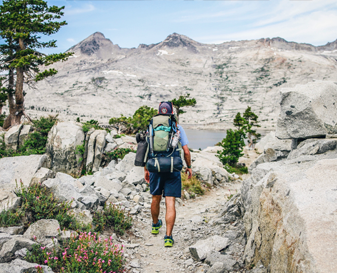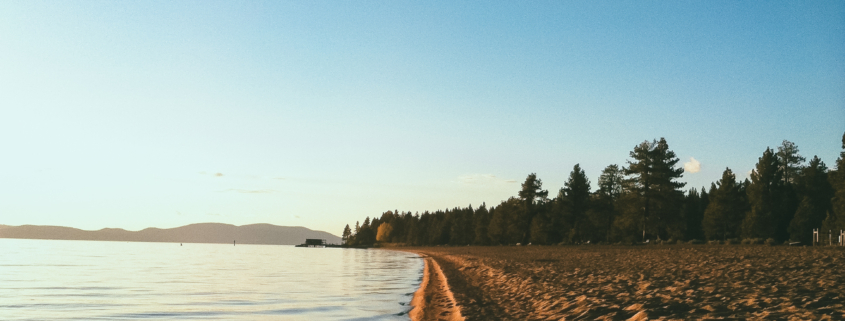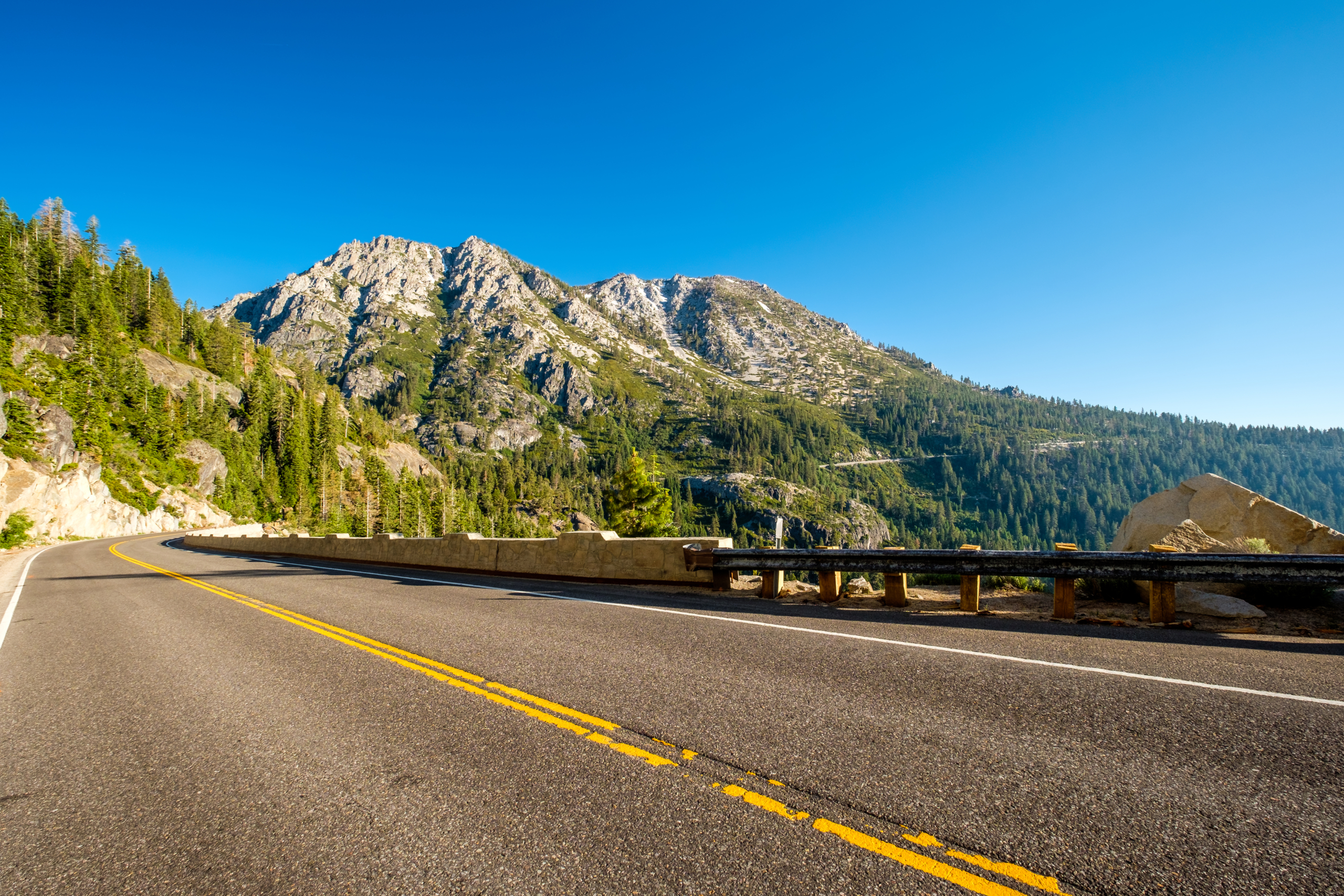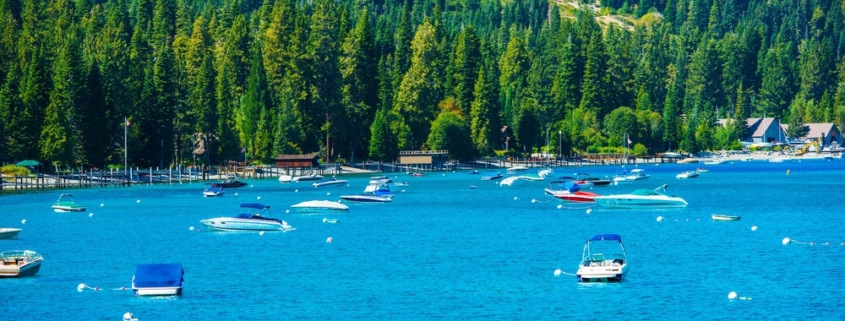One of the most beautiful ways to spend the day in the Lake Tahoe basin is going hiking. Here is a set of rules to help get you started hiking in Lake Tahoe.
Welcome to the breathtaking beauty of Lake Tahoe, where nature meets adventure! Nestled in the Sierra Nevada mountains of California and Nevada, Lake Tahoe is a mecca for outdoor enthusiasts looking for a mix of natural beauty and thrilling experiences. From hiking and biking to kayaking and fishing, the opportunities for adventure are endless.
The Eagle Falls Trail is a must-visit for hikers and nature enthusiasts looking for a challenging yet rewarding experience. Nestled in the heart of Lake Tahoe’s Emerald Bay, this 2.3-mile trail takes hikers on a journey through dense forests, past roaring waterfalls, and up to stunning vistas overlooking the crystal-clear waters of Eagle Lake.
Lake Tahoe is one of the most stunning natural wonders in the United States, with its crystal clear waters, breathtaking scenery, and lush forests. It is a popular destination for tourists and locals alike, attracting millions of visitors each year with its natural beauty and recreational opportunities.
However, despite its beauty and importance to the local community, Lake Tahoe’s environment is facing numerous challenges that threaten its long-term health and sustainability. These challenges include water quality degradation, loss of wildlife habitat, air pollution, and the spread of invasive species.
In light of these environmental challenges, it is crucial that we take action to protect and conserve Lake Tahoe for future generations. This blog is dedicated to exploring the environmental issues facing Lake Tahoe and the efforts being made to conserve and protect this unique and valuable ecosystem. Our aim is to educate and inspire readers to take an active role in preserving Lake Tahoe’s natural beauty and resources for years to come.
Overview of Lake Tahoe as a Natural Wonder
Lake Tahoe is a glistening gem in the Sierra Nevada mountain range, surrounded by towering peaks and lush forests. Its crystal clear waters are renowned for their stunning beauty, with a distinctive blue hue that is unlike anything else in the world.
The lake spans an area of over 190 square miles and is the second deepest lake in the United States, reaching depths of over 1,600 feet. It is fed by numerous streams and rivers, and its pristine waters are a haven for a variety of fish, plants, and wildlife.
The surrounding area is a nature lover’s paradise, offering endless opportunities for outdoor recreation and exploration. From hiking and camping to fishing and boating, Lake Tahoe offers a wealth of activities for people of all ages and interests.
In addition to its recreational offerings, Lake Tahoe is also an important source of water for the local community, providing irrigation for crops, drinking water for cities, and hydroelectric power for homes and businesses.
Lake Tahoe is a unique and invaluable resource, both as a natural wonder and as a source of water and recreation. It is a treasure that we must work to protect and preserve for future generations to enjoy.
Importance of Environmental Conservation for Lake Tahoe
The environmental health of Lake Tahoe is of critical importance for both the local community and the world at large. A healthy Lake Tahoe not only provides recreational opportunities, but it also supports local businesses, serves as a source of drinking water, and provides habitat for a variety of wildlife.
Unfortunately, Lake Tahoe is facing numerous environmental challenges, such as water quality degradation, loss of wildlife habitat, air pollution, and the spread of invasive species. These challenges threaten the long-term health and sustainability of the lake and the surrounding ecosystem.
It is therefore essential that we take action to protect and conserve Lake Tahoe. Environmental conservation efforts can help to mitigate the impacts of these challenges and ensure that Lake Tahoe remains a thriving ecosystem for years to come.
Some examples of conservation efforts include reducing air and water pollution, controlling the spread of invasive species, protecting wildlife habitat, and promoting sustainable recreational activities. These efforts are crucial for maintaining the health and balance of the lake and its surrounding ecosystem.
By taking an active role in environmental conservation, we can ensure that Lake Tahoe remains a natural wonder for future generations to enjoy. Whether it’s through reducing our impact on the environment, supporting conservation organizations, or simply being mindful of our actions while visiting the lake, we all have a role to play in preserving Lake Tahoe for the future.
So What Is This?
This blog is meant to educate and inform the public about the environmental challenges facing Lake Tahoe and the efforts being made to conserve and protect this valuable ecosystem. We aim to shed light on the critical importance of Lake Tahoe as a natural wonder and a source of water, recreation, and wildlife habitat.
Through this blog, we hope to raise awareness about the environmental issues facing Lake Tahoe and inspire readers to take an active role in protecting and preserving the lake for future generations. Whether you are a local resident, a frequent visitor, or simply someone who values the natural beauty of Lake Tahoe, we believe that you can make a positive impact by being informed and engaged.
Our blog will explore a range of topics related to Lake Tahoe’s environment, including water quality, wildlife habitat, air pollution, invasive species, and sustainable recreation. We will also highlight the efforts of local organizations and individuals who are working to conserve and protect Lake Tahoe.
Ultimately, our goal is to provide a comprehensive and accessible resource for anyone who is interested in learning more about Lake Tahoe and its environment. We believe that by working together and taking an active role in conservation, we can ensure that Lake Tahoe remains a natural wonder for generations to come.
Background on Lake Tahoe’s Environment
Lake Tahoe is a unique and valuable ecosystem, situated in the Sierra Nevada mountain range of California and Nevada. It is known for its clear, blue waters and stunning natural beauty, attracting millions of visitors every year.
However, this natural wonder is facing numerous environmental challenges that threaten its long-term health and sustainability. Some of the key challenges include water quality degradation, loss of wildlife habitat, air pollution, and the spread of invasive species.
Water quality is a major concern for Lake Tahoe, as pollutants from human activity, such as runoff from roads and development, can harm the lake’s delicate ecosystem. These pollutants can also negatively impact the clarity of the lake, reducing its distinctive blue color.
The loss of wildlife habitat is another significant challenge, as the surrounding forests and wetlands are crucial for the survival of many species of plants and animals. In addition, air pollution from vehicles, wildfires, and other sources can have a negative impact on the lake’s air quality and visibility.
Finally, the spread of invasive species is a growing concern, as these non-native plants and animals can outcompete native species for resources and alter the delicate balance of the ecosystem.
In order to protect and conserve Lake Tahoe for future generations, it is crucial that we address these environmental challenges and work to mitigate their impacts. Through sustainable practices, conservation efforts, and increased public awareness, we can ensure that Lake Tahoe remains a thriving ecosystem for years to come.
Geographical Features and Climate of Lake Tahoe
Located in the Sierra Nevada mountain range, Lake Tahoe is surrounded by breathtaking scenery, including snow-capped mountains, lush forests, and rolling meadows. The lake itself is renowned for its clear, blue waters and striking natural beauty.
Geographically, Lake Tahoe is located at an elevation of over 6,200 feet, making it one of the largest high-elevation lakes in North America. It covers an area of approximately 191 square miles and is 22 miles long and 12 miles wide.
The climate of Lake Tahoe is influenced by its location in the mountains, with cool summers and cold winters. The average temperature in the summer months is around 70 degrees Fahrenheit, while winter temperatures can drop below freezing. Snowfall is common in the winter months, providing opportunities for winter sports and recreation.
The precipitation that falls in the Lake Tahoe area helps to recharge the lake, which is a critical source of drinking water for the surrounding communities. The lake is fed by 63 streams and receives an average of over 44 inches of precipitation each year.
In addition to its stunning natural beauty, the unique geographical and climatic features of Lake Tahoe also provide a habitat for a variety of plants and animals, making it a vital and valuable ecosystem. By understanding and appreciating Lake Tahoe, we can work to protect and conserve this natural wonder for future generations.
Brief History of Human Impact on Lake Tahoe
Human activity has had a significant impact on Lake Tahoe and its surrounding ecosystem throughout history. While the lake has been a source of beauty and recreation for thousands of years, it has also been subject to various forms of human exploitation and degradation.
In the 19th century, the Lake Tahoe area saw significant development as settlers arrived and began to build homes and communities. This early development often involved logging and other forms of resource extraction, which had a negative impact on the lake’s ecosystem.
In the mid-20th century, Lake Tahoe saw a boom in tourism, as people flocked to the area to enjoy its natural beauty and recreational opportunities. This increased human activity brought new challenges, including water pollution, overuse of resources, and the spread of invasive species.
In recent decades, however, there has been a growing awareness of the importance of protecting Lake Tahoe and its environment. Local organizations, government agencies, and concerned citizens have come together to address the challenges facing the lake and work towards a more sustainable future.
Today, Lake Tahoe is subject to numerous conservation efforts, regulations, and programs aimed at mitigating the impacts of human activity and preserving its natural beauty for future generations. Through continued education, awareness, and action, we can ensure that Lake Tahoe remains a thriving and valuable ecosystem for years to come.
Current Environmental Challenges Facing Lake Tahoe
Despite decades of conservation efforts, Lake Tahoe still faces numerous environmental challenges that threaten its health and beauty. Some of the most pressing challenges include:
- Water Quality: Lake Tahoe is susceptible to water pollution from sources such as runoff, wastewater discharge, and the spread of invasive species. These pollutants can harm the lake’s delicate ecosystem, reducing its ability to support wildlife and providing clean water for humans.
- Invasive Species: The introduction of non-native species to Lake Tahoe has had a significant impact on its ecosystem. Invasive species, such as Eurasian watermilfoil, can outcompete native species for resources and alter the lake’s natural balance.
- Climate Change: Rising temperatures and changing precipitation patterns are having a significant impact on Lake Tahoe’s ecosystem. For example, the melting of mountain snowpacks can lead to increased runoff and erosion, while changes in the timing and intensity of precipitation can affect the lake’s water levels and water quality.
- Development: As the Lake Tahoe region continues to grow and develop, it is becoming increasingly important to protect the lake and its surrounding environment from the impacts of development. This includes managing the discharge of pollutants, preserving natural habitats, and reducing the spread of invasive species.
- Recreational Pressure: Lake Tahoe is a popular destination for recreation, including boating, fishing, and hiking. However, this increased human activity can also have negative impacts on the lake’s environment, such as water pollution, erosion, and the spread of invasive species.
In order to effectively address these environmental issues, it is important to understand their root causes and develop targeted management strategies that can help mitigate their impacts. This includes increased public education and engagement, as well as continued research and monitoring to better understand the challenges facing Lake Tahoe and its ecosystem.
Water Quality Degradation
One of the most pressing environmental issues facing Lake Tahoe is water quality degradation. This degradation is largely due to the runoff of pollutants from surrounding lands, which can carry substances such as nitrogen, phosphorus, and sediment into the lake. These pollutants can harm the lake’s delicate ecosystem and reduce its ability to support wildlife and provide clean water for humans.
One of the key factors contributing to water quality degradation is the increasing levels of nitrogen and phosphorus in the lake. These nutrients can promote the growth of harmful algal blooms, which can release toxic chemicals into the water and reduce its ability to support wildlife. In addition, sediment runoff can reduce the lake’s clarity, which is a key factor in its beauty.
Another factor contributing to water quality degradation is the discharge of pollutants from wastewater treatment facilities and other sources. These pollutants can include chemicals, heavy metals, and bacteria, which can harm the lake’s ecosystem and pose a risk to human health.
In order to protect the water quality of Lake Tahoe, it is important to address these issues through a range of management strategies. This includes reducing runoff and discharge from surrounding lands and treatment facilities, promoting best practices in land use and development, and monitoring the lake’s water quality to ensure that it remains healthy and sustainable.
It is also important to engage the public in the effort to protect Lake Tahoe’s water quality, through education and outreach programs that promote best practices and encourage individuals to take action to protect the lake. This can include reducing runoff from homes and businesses, supporting conservation efforts, and participating in monitoring and research programs. By working together, we can protect Lake Tahoe’s water quality and ensure that it remains a healthy and vibrant ecosystem for generations to come.
Loss of Wildlife Habitat
The loss of wildlife habitat is another pressing environmental issue facing Lake Tahoe. As human development continues to expand in the region, natural habitats such as forests, wetlands, and meadows are being destroyed or fragmented, reducing the amount of available habitat for wildlife. This can lead to declines in population numbers, genetic isolation, and a reduction in biodiversity.
One of the key drivers of habitat loss in Lake Tahoe is development and urbanization, which can reduce the amount of available habitat and disrupt migration patterns. In addition, the introduction of invasive species can also harm the lake’s ecosystem, altering the natural balance and reducing the amount of available habitat for native species.
In order to protect the wildlife habitat in Lake Tahoe, it is important to address these issues through a range of management strategies. This includes reducing development and urbanization, promoting best practices in land use and development, and monitoring the lake’s ecosystem to ensure that it remains healthy and sustainable.
It is also important to engage the public in the effort to protect Lake Tahoe’s wildlife habitat, through education and outreach programs that promote best practices and encourage individuals to take action to protect the lake. This can include supporting conservation efforts, volunteering for habitat restoration projects, and participating in monitoring and research programs. By working together, we can protect the wildlife habitat in Lake Tahoe and ensure that it remains a healthy and vibrant ecosystem for generations to come.
Air Pollution and Climate Change
Air pollution and climate change are two interrelated environmental issues that are affecting Lake Tahoe and its surrounding region. Air pollution, which includes emissions from vehicles, industry, and other sources, can have a negative impact on the lake’s ecosystem by altering the balance of species and reducing visibility. Climate change, which is causing global temperatures to rise and precipitation patterns to change, is also affecting the lake’s ecosystem by altering water temperature, reducing snow pack, and increasing the risk of wildfires.
One of the key impacts of air pollution and climate change on Lake Tahoe is reduced visibility, which is a critical factor in its beauty. In addition, changes in temperature and precipitation patterns can alter the lake’s ecosystem and reduce its ability to support wildlife.
In order to address these issues and protect Lake Tahoe from the impacts of air pollution and climate change, it is important to adopt a range of management strategies. This includes reducing emissions from vehicles and industry, promoting best practices in land use and development, and monitoring the lake’s ecosystem to ensure that it remains healthy and sustainable.
It is also important to engage the public in the effort to protect Lake Tahoe from the impacts of air pollution and climate change, through education and outreach programs that promote best practices and encourage individuals to take action to protect the lake. This can include reducing emissions from homes and businesses, supporting conservation efforts, and participating in monitoring and research programs. By working together, we can protect Lake Tahoe from the impacts of air pollution and climate change and ensure that it remains a healthy and vibrant ecosystem for generations to come.
Invasive Species and Forest Management
Invasive species and forest management are two critical environmental issues that are affecting Lake Tahoe and its surrounding region. Invasive species, which are non-native plants and animals that are introduced into a new ecosystem, can alter the natural balance and reduce the amount of available habitat for native species. Forest management, which involves managing the growth and health of forests in the region, is also critical to ensuring the sustainability of Lake Tahoe’s ecosystem.
One of the key impacts of invasive species on Lake Tahoe is the alteration of the natural balance of species, which can reduce the amount of available habitat for native species and increase the risk of ecosystem degradation. In addition, poor forest management practices, such as over-logging or mismanagement of forest fires, can have a negative impact on the lake’s ecosystem by altering the balance of species and reducing the amount of available habitat.
In order to address these issues and protect Lake Tahoe from the impacts of invasive species and poor forest management, it is important to adopt a range of management strategies. This includes reducing the introduction of invasive species, promoting best practices in forest management, and monitoring the lake’s ecosystem to ensure that it remains healthy and sustainable.
It is also important to engage the public in the effort to protect Lake Tahoe from the impacts of invasive species and poor forest management, through education and outreach programs that promote best practices and encourage individuals to take action to protect the lake. This can include supporting conservation efforts, volunteering for habitat restoration projects, and participating in monitoring and research programs. By working together, we can protect Lake Tahoe from the impacts of invasive species and poor forest management and ensure that it remains a healthy and vibrant ecosystem for generations to come.
Overview of Conservation Organizations and Government Agencies Working in Lake Tahoe
There are a number of conservation organizations and government agencies working to protect and conserve Lake Tahoe and its surrounding region. These organizations and agencies are dedicated to ensuring the sustainability of the lake’s ecosystem, and they play an important role in addressing the environmental challenges facing Lake Tahoe.
Some of the key organizations and agencies working in Lake Tahoe include the League to Save Lake Tahoe, the Tahoe Regional Planning Agency, and the U.S. Forest Service. These organizations and agencies work together to develop and implement management plans, conduct research and monitoring, and engage the public in conservation efforts.
The League to Save Lake Tahoe, for example, is a non-profit organization dedicated to protecting and restoring the lake’s ecosystem. The organization works to promote best practices in land use and development, reduce emissions from vehicles and industry, and support conservation efforts.
The Tahoe Regional Planning Agency, on the other hand, is a bi-state agency responsible for managing land use and development in the Lake Tahoe region. The agency works to ensure that development in the region is sustainable, and it is involved in a range of programs and initiatives aimed at protecting and conserving the lake’s ecosystem.
The U.S. Forest Service, which manages the Lake Tahoe Basin Management Unit, is also involved in a range of conservation efforts in the region. The agency works to protect and restore the lake’s ecosystem, and it is involved in programs to reduce the risk of forest fires, promote sustainable forest management, and improve water quality.
By working together, these organizations and agencies are making a significant impact in protecting Lake Tahoe and its surrounding region. They are playing a critical role in addressing the environmental challenges facing the lake, and they are ensuring that it remains a healthy and vibrant ecosystem for generations to come.
Discussion of Ongoing Conservation Programs and Projects
Lake Tahoe is home to a number of ongoing conservation programs and projects aimed at protecting and conserving the lake’s ecosystem. These programs and projects cover a range of issues, from improving water quality and reducing air pollution to restoring wildlife habitat and managing invasive species.
One of the key programs underway in Lake Tahoe is the Lake Tahoe Environmental Improvement Program (EIP). The EIP is a comprehensive effort to improve the lake’s environment, and it covers a range of activities, from reducing emissions from vehicles and industry to restoring wildlife habitat and improving water quality.
Another important conservation program is the Lake Tahoe Watershed Assessment, which is focused on improving the lake’s water quality. This program involves a range of activities, including monitoring water quality, tracking pollutants, and developing strategies to reduce the impact of pollutants on the lake.
There are also a number of projects underway to manage invasive species and improve forest management in the Lake Tahoe region. These projects involve removing invasive species, such as the Asian clam and the Tahoe yellow cress, and promoting the growth of native species, such as the Jeffery pine and the mountain bluebell.
In addition to these programs and projects, there are also a number of conservation organizations and government agencies working to protect and conserve Lake Tahoe. These organizations and agencies play an important role in raising awareness about the environmental challenges facing the lake, and they are involved in a range of initiatives aimed at improving the lake’s ecosystem.
There are many ongoing conservation programs and projects aimed at protecting and conserving Lake Tahoe and its surrounding region. These programs and projects cover a range of issues, and they are making a significant impact in addressing the environmental challenges facing the lake. By working together, these organizations and agencies are ensuring that Lake Tahoe remains a healthy and vibrant ecosystem for generations to come.
Success Stories and Positive Outcomes of Conservation Efforts in Lake Tahoe
Over the years, there have been many successful conservation efforts in Lake Tahoe that have helped to improve the health of the lake’s ecosystem. These efforts have had a range of positive outcomes, from improving water quality and reducing air pollution to restoring wildlife habitat and managing invasive species.
One of the key success stories in Lake Tahoe is the improvement in water quality. Thanks to the ongoing efforts of conservation organizations and government agencies, the lake’s water clarity has increased by over 10 feet since the 1990s. This has had a positive impact on the lake’s ecosystem, as well as its recreational and tourism industries.
Another positive outcome of conservation efforts in Lake Tahoe is the reduction in air pollution. Through initiatives aimed at reducing emissions from vehicles and industry, the air quality in the region has improved significantly. This has helped to protect the health of both the lake’s ecosystem and the people who live and visit the area.
The restoration of wildlife habitat is also a success story in Lake Tahoe. Through a range of initiatives aimed at improving forest management and controlling invasive species, the region has seen a significant increase in the populations of native species, such as the bald eagle and the Tahoe yellow cress.
In addition to these success stories, there are also a number of positive outcomes related to the ongoing management of invasive species in Lake Tahoe. Through efforts to remove invasive species and promote the growth of native species, the lake’s ecosystem has become more resilient and better able to withstand the impacts of climate change and other environmental challenges.
There have been many successful conservation efforts in Lake Tahoe that have had a range of positive outcomes. These efforts have helped to improve water quality, reduce air pollution, restore wildlife habitat, and manage invasive species. By continuing to work together, conservation organizations and government agencies can ensure that Lake Tahoe remains a healthy and vibrant ecosystem for generations to come.
Simple Actions for Individuals to Help Protect Lake Tahoe’s Environment
Everyone can play a role in protecting the environment of Lake Tahoe. Here are some simple actions that individuals can take to help conserve this natural wonder:
- Reduce energy consumption: By reducing the amount of energy you use at home, you can help to reduce the amount of greenhouse gas emissions that contribute to climate change. Simple actions, such as turning off lights when you leave a room, using energy-efficient appliances, and carpooling, can all make a difference.
- Reduce waste: By reducing the amount of waste you generate, you can help to reduce the amount of pollution that enters Lake Tahoe. Simple actions, such as recycling and composting, can help to keep waste out of the landfill and protect the lake’s ecosystem.
- Use public transportation or bike: By choosing to use public transportation or bike instead of driving, you can help to reduce the amount of air pollution and greenhouse gas emissions that contribute to climate change.
- Support conservation organizations: By supporting conservation organizations that work to protect Lake Tahoe, you can help to ensure that this natural wonder is protected for future generations. This can include making a donation, volunteering, or spreading the word about the importance of conservation.
- Follow Leave No Trace principles: When visiting Lake Tahoe, it is important to follow the Leave No Trace principles, which are designed to minimize the impact of visitors on the environment. This includes following trails, respecting wildlife, and properly disposing of waste.
- Vote for environmental protections: By using your voice and your vote, you can help to protect the environment of Lake Tahoe. This includes supporting candidates who prioritize conservation and environmental protections, as well as advocating for policies that help to reduce pollution and protect the lake’s ecosystem.
There are many simple actions that individuals can take to help protect Lake Tahoe’s environment. By taking these actions, we can all play a role in ensuring that this natural wonder remains healthy and vibrant for generations to come.
Opportunities for Volunteering and Supporting Conservation Organizations
One of the most effective ways to help protect Lake Tahoe’s environment is to get involved and support conservation organizations. There are many opportunities to volunteer, donate, and support organizations that work to conserve this natural wonder, including:
- Volunteer with conservation organizations: Many conservation organizations offer opportunities for volunteers to get involved in projects that help to protect Lake Tahoe’s environment. This can include planting trees, removing invasive species, monitoring wildlife, and more.
- Support conservation organizations through donations: Financial support is critical to the success of conservation organizations working to protect Lake Tahoe. By making a donation, you can help to fund conservation efforts, research, and education programs.
- Participate in advocacy campaigns: Conservation organizations often organize advocacy campaigns to help protect Lake Tahoe’s environment. By participating in these campaigns, you can help to raise awareness about important environmental issues and advocate for policies that help to protect the lake’s ecosystem.
- Attend educational events: Conservation organizations often host educational events, such as lectures, workshops, and guided hikes, to help raise awareness about Lake Tahoe’s environment and the importance of conservation. By attending these events, you can learn more about the lake’s ecosystem and how to help protect it.
- Support local businesses that prioritize conservation: By supporting local businesses that prioritize conservation, you can help to ensure that Lake Tahoe’s environment is protected for future generations. This can include choosing to stay at environmentally-friendly hotels, eating at restaurants that source sustainable ingredients, and shopping at stores that sell environmentally-friendly products.
In conclusion, there are many opportunities for individuals to get involved and support conservation organizations working to protect Lake Tahoe’s environment. Whether you choose to volunteer, donate, participate in advocacy campaigns, or support local businesses, your actions can help to ensure that this natural wonder remains healthy and vibrant for generations to come.
How to Advocate for Environmental Conservation in Lake Tahoe
Advocating for environmental conservation in Lake Tahoe is a critical component of protecting this natural wonder for future generations. Here are some ways you can become an advocate for conservation:
- Stay informed: The first step in advocating for environmental conservation is staying informed about the issues facing Lake Tahoe’s ecosystem. This can include reading news articles, attending events hosted by conservation organizations, and following relevant social media accounts.
- Write to your elected officials: Elected officials have the power to make decisions that impact Lake Tahoe’s environment. By writing to your elected officials, you can express your support for conservation efforts and encourage them to prioritize environmental protection.
- Participate in advocacy campaigns: Conservation organizations often organize advocacy campaigns to help protect Lake Tahoe’s environment. By participating in these campaigns, you can help to raise awareness about important environmental issues and advocate for policies that help to protect the lake’s ecosystem.
- Support local businesses that prioritize conservation: By supporting local businesses that prioritize conservation, you can help to ensure that Lake Tahoe’s environment is protected for future generations. This can include choosing to stay at environmentally-friendly hotels, eating at restaurants that source sustainable ingredients, and shopping at stores that sell environmentally-friendly products.
- Spread the word: Finally, you can help to advocate for environmental conservation by sharing information about Lake Tahoe’s environment with your friends, family, and community. This can include sharing news articles, attending educational events, and promoting conservation efforts on social media.
Advocating for environmental conservation in Lake Tahoe is a critical component of protecting this natural wonder for future generations. By staying informed, writing to your elected officials, participating in advocacy campaigns, supporting local businesses, and spreading the word, you can help to ensure that Lake Tahoe’s environment remains healthy and vibrant for years to come.
The Importance of Environmental Conservation for Lake Tahoe
In this blog, we’ve discussed the importance of environmental conservation for Lake Tahoe, one of the most beautiful natural wonders in the world. We started with a brief overview of Lake Tahoe as a natural wonder and its geographical features and climate. We then explored the background on Lake Tahoe’s environment, including its history of human impact and the current environmental challenges facing the lake.
We delved into the key environmental issues impacting Lake Tahoe, including water quality degradation, loss of wildlife habitat, air pollution and climate change, and invasive species and forest management. We then discussed the ongoing conservation efforts by organizations and government agencies, including ongoing programs and projects, success stories, and positive outcomes of conservation efforts in the lake.
We also highlighted the simple actions that individuals can take to help protect Lake Tahoe’s environment, including reducing water usage, supporting local businesses that prioritize conservation, and participating in advocacy campaigns. Finally, we discussed the importance of volunteering and supporting conservation organizations, as well as advocating for environmental conservation in Lake Tahoe.
In conclusion, environmental conservation is critical for the protection and preservation of Lake Tahoe, one of the world’s most beautiful natural wonders. Whether it’s through simple actions, volunteering, or advocating, each of us has the power to help ensure that Lake Tahoe remains healthy and vibrant for generations to come.
Call to Action for Readers to Get Involved and Protect Lake Tahoe’s Environment
It’s time for us to take action. Lake Tahoe is one of the most beautiful and unique natural wonders in the world, and it’s up to all of us to protect and preserve it for future generations.
Here are some ways you can get involved and make a difference in protecting Lake Tahoe’s environment:
- Reduce your water usage and make a conscious effort to conserve water.
- Support local businesses that prioritize environmental conservation and sustainable practices.
- Participate in advocacy campaigns and raise your voice in support of conservation initiatives.
- Volunteer with organizations and government agencies working to protect Lake Tahoe’s environment.
- Make a donation to support conservation organizations and their efforts to protect Lake Tahoe.
- Spread the word and educate others about the importance of environmental conservation for Lake Tahoe.
Your actions, no matter how small, can make a significant impact in protecting Lake Tahoe’s environment. So, let’s get started and work together to preserve this amazing natural wonder for future generations to enjoy.
It’s up to all of us to take action and protect Lake Tahoe’s environment. Whether it’s through simple actions, volunteering, or advocating, each of us has the power to make a difference. Let’s take this opportunity to get involved and ensure that Lake Tahoe remains healthy and vibrant for generations to come.
It’s time to reflect on the future of this beautiful natural wonder. Lake Tahoe has faced many challenges over the years, but with the efforts of conservation organizations, government agencies, and individuals like you and me, it has the potential to thrive for many years to come.
The future of Lake Tahoe’s environment is in our hands, and it’s up to us to ensure that it remains healthy and protected. By continuing to make sustainable choices and supporting conservation initiatives, we can ensure that Lake Tahoe remains a vibrant and thriving ecosystem for generations to come.
Lake Tahoe is a popular tourist destination known for its stunning scenery and outdoor recreation opportunities, but it’s also a hub for nightlife and entertainment.
Kayaking is a popular outdoor activity that can be enjoyed by people of all ages and skill levels. With its crystal-clear waters and stunning mountain views, Lake Tahoe is an ideal destination for kayaking enthusiasts. In this article, we will be discussing the top 10 kayak rentals in Lake Tahoe, so you can plan your next adventure on the water.






